Post by Daniel Heyman
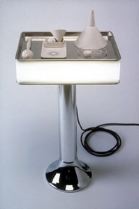
[ed. note: Clay Studio resident artist Julie York‘s exhibit at Garth Clark Gallery on 57th St. runs to Aug. 13.]
What has been consistent with Julie York’s sculpture and what makes it so compelling is her stunning and cool arrangements.
York arranges easily identified porcelain slip cast objects in installation settings, often and most strikingly placing large clusters of these objects in light and liquid filled clear tanks bringing ceramics to the doorstep of conceptual art the way a cat leaves a dead mouse at the foot of its owner.
The objects reproduced are both dispassionate and mundane — casts of metal trays, funnels, beakers, tooth brushes, all mass produced items, anonymous in their own right, yet made even more so by their reproduction.
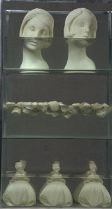
The objects, quite often 20 or more from the same mold, are meticulously arranged in grids on the floor or stacked in beautiful glass or plexiglas display cases, often filled with oil or water.
In one work, “Beauty Distilled” from 1999/2000 (shown left), York created a three level glass and metal tank, with cast dolls on the first level, muffins on the second, and two large mannequin’s heads on the third, with the objects on each level half submerged in water. The effect is eerie, and it is difficult to decide upon the correct aesthetic response.
What’s a viewer to do?
Is this work so hermetically sealed that there is little space for the viewer to connect with the works? Is it a feminist critique only? Or, more sympathetically, is this careful and clean arranging a defense against the gluttony of the material world which can seem burdensome by its very excess? I opt for the latter, and leave to others the feminist interpretations that seem too dated and obvious to be compelling.
There is in these queer and distilled placements of objects a poise and confidence that forces me again and again to marvel at the sheer beauty York has placed before me and be satisfied irrespective of any particular conceptual point.
Spacey specimens
York casts of industrial objects are artifacts from the city around her. Remarkably, these eerie arrangements have the attraction of HAL, the onboard space age computer from “2001: A Space Odyssey,” setting an atmosphere so perfect that human interaction is not only irrelevant, but an interference. In a time where the debates of the day include the cloning of spinal tissues from embryos and more and more babies are conceived through the help of “fertility technologies,” York’s work is right on.
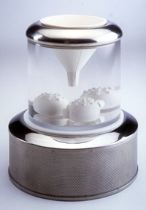
One such work is “Specimen #0408” (right) from York’s 2003 exhibition at the Clay Studio in Philadelphia. The work is made of porcelain, metal, plastic, oil and light, and comprises a porcelain cast of a funnel set in a metal ring on a clear plastic jar, in which sit three smaller cast objects. The jar itself sits above a round metal tray, the kind of object one thinks is familiar, but when asked to name it one finds it elusive, mixed in with the vague memories of high school science. The piece is lit from under the plastic jar, a sharply colored, specifically unnatural light. Specimen of what? Whose specimen?
Another work, “Word Blindness,” 2003, (below) is a large plastic tank with three levels: the bottom level is translucent radiating a pale yellow light; the middle level houses casts of cake molds and is half filled with water – the innumerable reflections and refractions transfixing our gaze; the top level again filled half way with water in which multiple porcelain casts of funnels of several sizes are strewn. Amidst the beauty, for this work is exceptionally beautiful, there is an ominous, creepy feeling, much stronger than the earlier works.
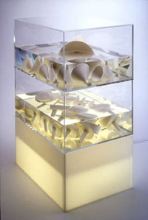
The work creates the aura of an operating chamber, a place of strict cleanliness that is nonetheless a battleground full of blood and infection. I keep thinking of futuristic movies as a context for understanding this work, where somehow the softness of human interaction has been replaced by the proficiency of a mechanized world. There is a fascination in staring into this perfect world, and like a deer looking into the headlights of an onrushing car, York’s work pulls us in and holds our gaze. We poor viewers are as helpless as Narcissus, mesmerized by beauty even as it immobilizes us.
A native of Vancouver, graduate of Alfred University and the Emily Carr Institute, York came to Philadelphia as an Evelyn Shapiro Foundation Fellow at The Clay Studio, where she remains an artist in residence. Before arriving in Philadelphia, York worked in white earthenware, making objects with a more recognizable feminine content. She cast series of dolls, cupcakes, and mannequin heads. She put the dolls heads on lamb’s bodies, and made casts of tea pots and irons.
Grown up clay vs kiddie clay
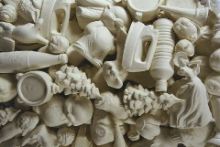
York relishes porcelain’s seductive purity. She loves the material, its denseness, its plasticity, the way it becomes so sensual when sanded to a smooth surface. She calls porcelain the grown-up clay – less likely to misbehave but also less forgiving. But the porcelain objects are never the completed piece, and to view them as such would be missing the point. She feels that porcelain, and by extension all clay, remains wide open as an artistic material precisely because so many of the artists working in clay see their work only within the realm of ceramics, and those outside the ceramics world rarely consider clay, with all its inherent materiality, as a convenient expressive medium.
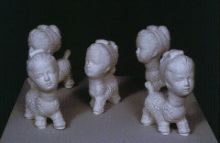
Unhappy with the way the earlier objects controlled the work’s content, (you can’t really escape that a doll comes with a load of associations), York destroyed all of her previous molds before arriving at The Clay Studio, ready to utilize the move as an opportunity to develop a new vocabulary.
–Daniel Heyman is a Philadelphia artist on the faculty of Philadelphia University. You can see his work currently in “Philadelphia Selections 5” at Moore College of Art, at the JMS Gallery in Chestnut Hill, and at the Silas Kenyon Gallery in Provinceton, MA. Look for his Fleisher Challenge exhibit in Feb. 2005.









